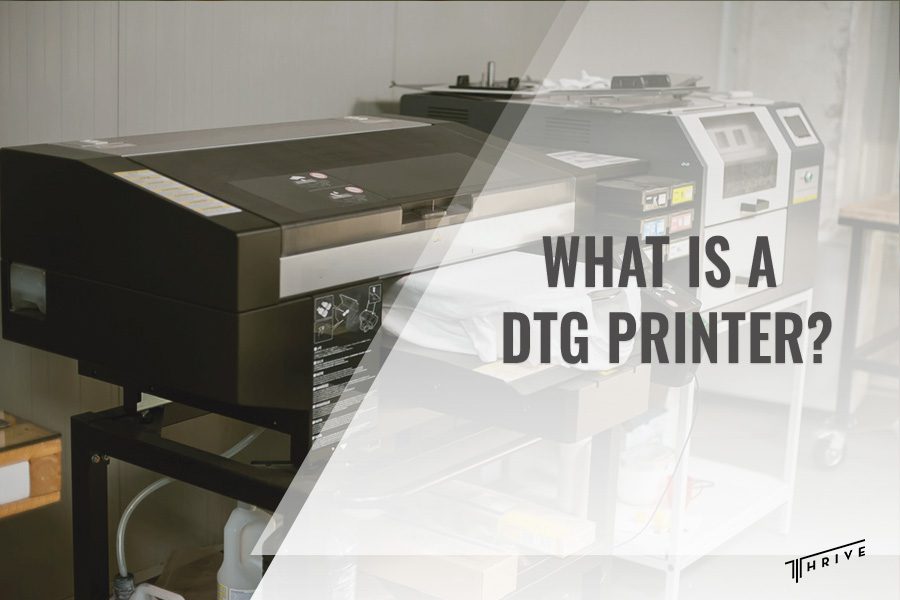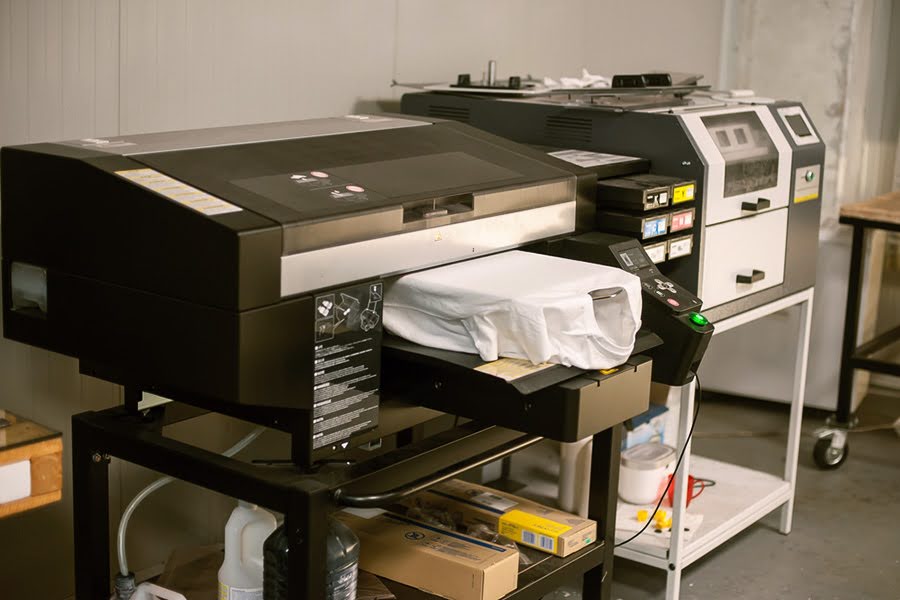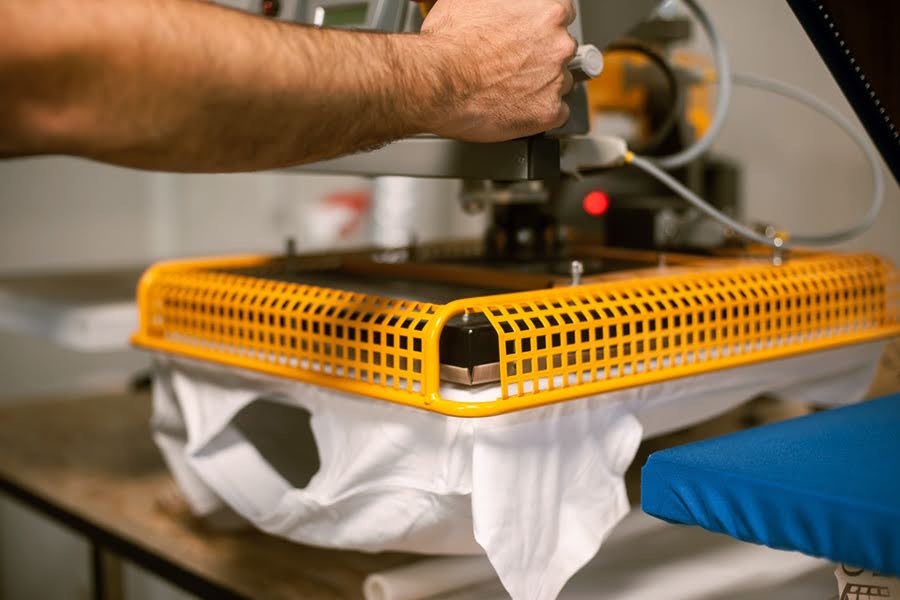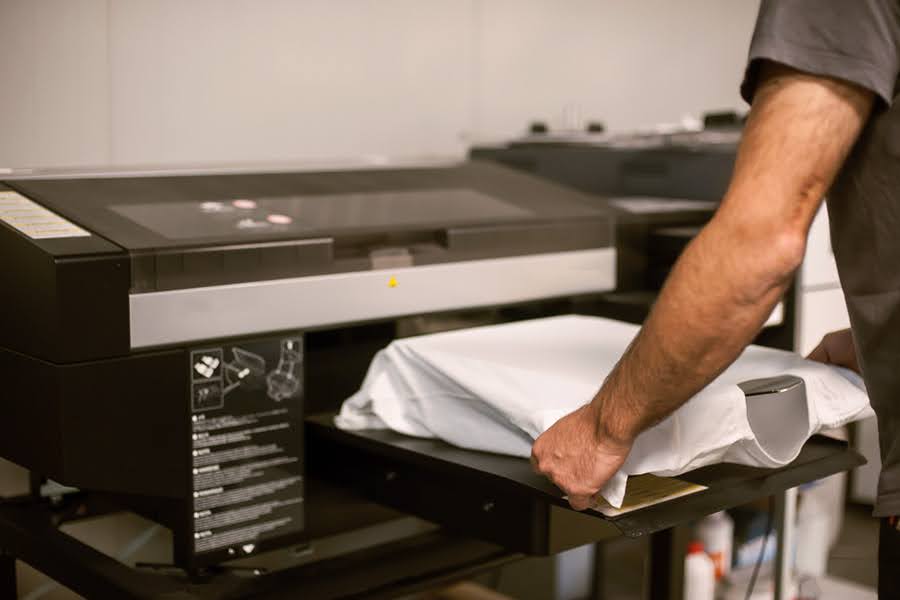
In the ever-evolving world of print technology, understanding the latest advancements is crucial to staying ahead of the industry. This article explores the realms of modern printing solutions, explaining what is DTG printer and its applications.
It’s important to emphasize that this type of printing technology has revolutionized how graphics are transferred to apparel. As experts in the industry, we witnessed the rise and evolution of DTG printers and understand their impact and significance.
In the following, we’ll explore different aspects of DTG printing and explain how DTG printers work, their speed, best applications, advantages, and more.
What Is a DTG Printer?
A DTG (direct-to-garment) printer is a specialized digital printer that transfers designs to textiles. DTG printers spray ink directly into the surface of the chosen garment. They are popular for the sharp images and high precision visible in their print.
The DTG printing method is suitable for a wide range of different textiles and garments. Some of the most common apparel in direct-to-garment printing include T-shirts, hoodies, hats, tote bags, and other fabric products.

How Do DTG Printers Work?
One of the hallmarks of this DTG technology is that these printers eliminate the extensive preparation phase, which is crucial to more traditional techniques like screen printing. However, some preparation goes into the direct-to-garment process.
Read through the subsections below where we explain our wholesale DTG printing process:
Preparation
Within the preparation phase of DTG printing, we pretreat the chosen garment with a solution to ensure that it doesn’t wash off and the colors remain vibrant. The pre-treatment procedure can be done either manually or by using a specialized machine.
If doing so manually, it’s important to use a pretreatment mix and spray through the entire surface as evenly as possible. The process is more straightforward when using a machine, as you only need to push a button.
Once the pre-treatment is finished, the garment is heat-pressed for around 30 seconds to ensure it dries properly.
Printing
After properly drying the garment, we place it into the printing machine. Locking in the garment is essential as this will prevent it from moving and ensure the print is transferred accurately.
Some platens might be equipped with a corresponding frame that can stretch the garment and lock it in place. When a frame isn’t available, the garment can be fitted on the platen. This is only possible with wearable garments such as T-shirts, hoodies, and trousers.
Before the machine begins printing, we apply white ink under the base onto the garment to enhance color vibrancy in the final result. The under-base layer should cover the entire printing area, and this is done in all garments except white ones.
Once the under base has been added, the DTG printer transfers our chosen design onto the garment.
Curing
Curing is the final step in the DTG printing procedure. This process helps cure the ink and enhances the durability of the print. It can be done in two ways – using a heat press or using a conveyor dryer.
The heat press method is usually reserved for smaller printing businesses as it gets more labor-intensive when more garments are involved. Large-scale manufacturers typically use a conveyor dryer.
The heat press curing process is simple. To stabilize the ink, the printed apparel is placed in the heat press, and parameters on the machine are set to match the ink characteristics.
Conveyor dryers can easily accommodate different garment sizes, making the curing process faster when printing in a larger capacity. These machines offer a greater heat consistency as these machines operate by moving garments through a heat chamber.
Types of DTG Printers
Entry-level DTG printers
Entry-level DTG printers have a more compact size and come with a limited set of capabilities. They are usually limited in terms of the material they may transfer print to. Due to their size and performance, they are mainly used in home studios or small retail stores.
Commercial DTG printers
Commercial DTG printers have a full spectrum of capabilities. These models feature the white ink needed to create the underbase. Their print-management software is more sophisticated than entry-level printers and offers a more precise preview of the final color design.
Industrial DTG printers
Industrial DTG printers come with a diverse skill set. These printers usually hold three platens, bulk ink systems, and specialized features such as automatic wrinkle detection.
One of the many differences between commercial and industrial DTG printers is printing time. Some industrial printers may transfer the design in as little as 30 seconds. The typical printing time in commercial printers is usually between three to five minutes.

What Is DTG Printing Best Suited For?
DTG prints work best with natural fabrics. One well-known principle in the textile printing industry is that garments used in DTG printing should feature at least 50% cotton. However, this doesn’t mean that DTG printing on polyester is not possible.
DTG printing can be used when printing on polyester shirts, but the process becomes challenging when transferring ink on garments with a higher polyester count. The results will likely not be as satisfying as when printing on a cotton shirt. When printing on 100% polyester fabric, less ink is able to penetrate the fabric, which is why clothes with a high polyester count might not be ideal for DTG printing.
What we consider the best fabrics for DTG printing include cotton, organic cotton, ring-spun cotton, combined cotton, linen, and poly-blends.
How Fast Is DTG Printing?
DTG printing is a relatively fast process. Transferring a print using this method usually requires no more than a few minutes. Being a process with minimal setup preparation, the only time-consuming aspect lies in programming the heat press.
Creating the printing design is another part of this printing process that we find most time-consuming. However, this differs based on complexity. Once the design is prepared, the rest of the operation might typically take between three to five minutes.
DTG Printer Advantages
High quality
Direct-to-garment printing is an excellent choice for those looking for photo-realistic prints. For many, this is the preferred method when printing high-detail apparel. Unlike other methods, such as screen printing, the color choices are limitless, offering much freedom in design.
Personalization
This printing method helps us cater to an array of customers with different needs and ideas for their designs. As explained earlier, being purely digital, this process utilizes computerized technology to transfer designs onto apparel exactly as they are.
DTG makes a great option when printing parts of the garment that are tricky or impossible to print with other methods. This method helps us transfer visuals over zippers, pockets, seams, and shoulders seamlessly.
Due to its digital nature, we can offer customers limitless options when choosing the printing design. What is more, DTG printing is also faster and less time-consuming when compared to other methods.
Eco-friendly
The application of this technique goes beyond quality and versatility. DTG is also environmentally friendly. The inks used in DTG are usually water-based and have a minimum production waste. This process involves no more than two to three machines, which also helps lower energy consumption.
Small business operation
In DTG printing, there is no minimum order limit, and customers can choose to print as little as a single garment. This is why DTG printers are usually preferred for small-level production. The setup for DTG printing is minimal and doesn’t require much space. All that one might need to start a small-scale DTG printing business is enough space for the printer, the computer, and the curing machine.

Conclusion
In conclusion, we may say that DTG printing represents a significant advancement in printing technology, especially in the apparel industry. The detailed graphics and high-quality prints are what make DTG printers an attractive option. Nevertheless, we find the level of flexibility and customization options to be their winning characteristics.
However, we should always keep in mind what is a DTG printer best suited for and what type of fabric might not be the best choice. This is one of the most critical aspects, as the quality of the print largely depends on the type of medium it is transferred to.

Robert Fisher is the founder and CEO of Thrive Screen Printing and brings extensive experience in the screen printing and fulfillment industry.

